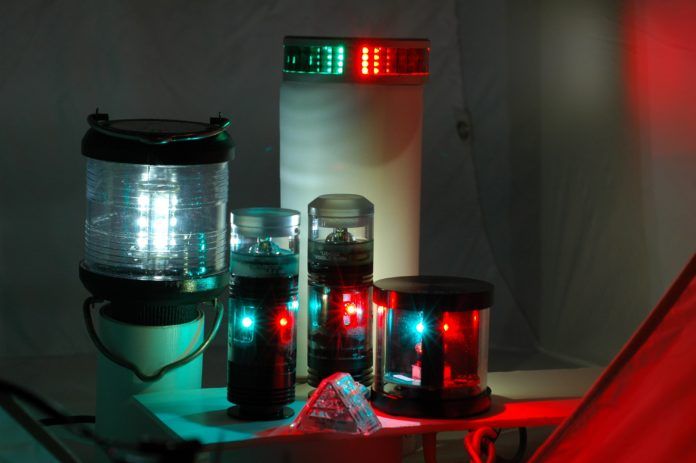The U.S. Coast Guard has determined that an increasing number navigation lights being used on sailboats do not meet the basic requirements for these lights, making them less visible to nearby ships. According to the Coast Guard’s Inspections and Compliance Directorate, part of the problem is that some owners are retrofitting existing incandescent nav lights with LED lights, or LED components that were designed for powerboats. Manufacturers are also at fault, to some degree, for not clearly labeling navigation lights designed for sailboats.
In mid-March, the Coast Guard’s Inspections and Compliance Directorate published Marine Safety Alert 02-19, Not all navigation lights are created equal, to assist all mariners in understanding the difference between navigation lights used on power driven vessels and those used on sailing vessels.
Navigation lights intended for use on power driven vessels may be different from navigation lights intended for use on sailing vessels. Although the horizontal arc of visibility is the same for all lights, the vertical divergence (i.e. vertical arc of visibility) requirements for lights on vessels under sail are larger to accommodate greater heeling. Manufacturer labeling may not discriminate between the different requirements. Navigation lights that claim compliance with the navigation rules may meet the vertical visibility requirements for a power driven vessel, however, they may not comply with the vertical visibility standards for sailing vessels.
It isn’t always easy for sailors to confirm they are purchasing the right light. Manufacturer labeling may not indicate that the lights are designed for use on power-driven vessels only. In some cases, you’ll have to contact the manufacturer or search for this detail in the specification sheets to determine whether the light is approved for sailboats. Most brand-name lights marketed for use on sailboats do meet the vertical angle requirements according to the Coast Guard.
Annex I (COLREGs section 10 and Inland 33 C.F.R. part 84.16 Vertical sectors) prescribes the degrees and intensities that navigation lights must meet on the vertical plane. Many boat owners may not be aware of the +/- 25 degreevertical light divergence requirement for sailing vessels, a 17.5 degreeincrease from the power-driven vessel standard. Installing a navigation light, designed for use on a power driven vessel, on a sailing vessel may result in the light losing visibility when the vessel heels beyond the narrower +/- 7.5 degreevertical divergence angle established for power-driven vessels. A sailing vessel operator in this situation would likely not realize that the sailing vessels lights were not visible when heeling beyond 7.5 degree.

What does this mean?
If your sailboat does not have the correct lights (sidelights, masthead lights, all-round lights, and/or combined lantern) and it heels past a certain degree, it may not be observable by other vessel operators.
Why is that important?
You may not know that other vessels cannot see you due to the heel of your vessel. Failure to operate with the correct navigation lights may create a situation where you mistakenly believe another mariner is able to ascertain your vessels aspect or operational condition, which increases risk of collision.

Although a navigation light designed for a sailing vessel will have a greater vertical visibility than required for a power driven vessel, it does not pose a commensurate safety concern and it is permissible for a sailboat to show these lights when powering (see diagram above). Manufacturers should be aware of the larger vertical visibility requirement for lights installed on sailing vessels. Likewise, sailing vessel operators and vessel repair facilities should ensure the installed lights meet the applicable requirements in Annex I. Since not all navigation lights are designed similarly, ensure that when you install a navigation light it is USCG certified for the length and type of boat. Such information should be readily available from reputable sources such as the light or vessel manufacturer.
Safety Alert 02-19is provided for informational purposes only and does not relieve any domestic or international safety, operational, or material requirement. It was developed and distributed by theOffice of Navigation Systems.Questions may be sent to[email protected].
For more on LED navigation lights see our February 2010 report, as well as our February 2019 Special Report on how to determine if yournavigation lights are interfering with your AIS.







































